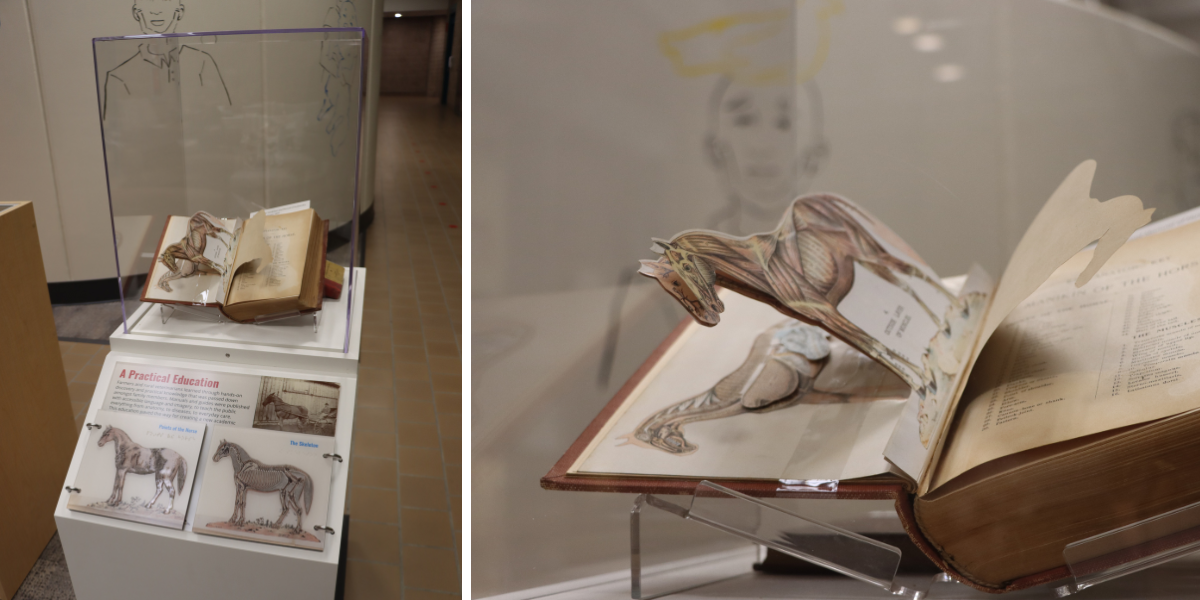Turning the page
The Minnesota Veterinary History Museum has a new location and a new vision for using the past—and present—to inspire the future of veterinary medicine

The Minnesota Veterinary History Museum has a new location and a new vision for using the past—and present—to inspire the future of veterinary medicine
Mari Kuennen, curator and director of the Minnesota Veterinary History Museum, presents one of the museum's new interactive displays, which lets visitors listen to short recordings of oral histories gathered from prominent figures in College of Veterinary Medicine history.
The artifacts lining display cases of the Minnesota Veterinary History Museum may reflect the past, but curator Mari Kuennen hopes to use these and other records to build a bridge to the future of the field.
Established in 1985, the museum is housed in the College of Veterinary Medicine (CVM) and has long served as a repository for veterinary items, from books to tools to interview recordings to preserved skeletons and more—about 6,000 items in all.
It’s Kuennen’s vision for these objects and new acquisitions to play a larger role than sitting on a shelf to be admired. She wants the museum and its exhibits to reflect the storied legacy of veterinary medicine while contributing to contemporary conversations and connecting people.
“It’s looking at how we as a museum can build community, and not just at the college,” she says. “It’s going beyond that by inspiring new generations of veterinarians and getting people excited and interested in our stories.”

As part of those efforts, the museum has moved to a new space in the second-floor atrium of the Lewis Small Animal Hospital at the University of Minnesota. There, expanded displays bring context to mysterious relics and new interactive exhibits offer visitors a chance to connect with history through audio recordings and tactile elements.
These changes are laying the foundation for the museum to take a more active role in preserving history and using the collections to add context to current conversations around demographic shifts, cultural awareness, and more.
The new location is one of several transitions the museum has undergone in recent years.
Faculty, alumni, and community volunteers kept the museum operating through the decades as an independent organization, but the museum became an official part of the College of Veterinary Medicine in 2023. Kuennen was hired as director and curator in April 2022 and using her background in museum studies, art history, and archeology, she’s worked to elevate the exhibits, conduct outreach, and manage its ever-growing collection.
Many of the items on display have been donated through the decades by CVM alumni and other veterinary professionals. They’re products of their time, not only a reflection of the medicine practiced but those who were behind it. Over the decades, the demographics of veterinary medicine have shifted from a male-dominated field to one where women account for the overwhelming majority of clinicians. The field also is slowly becoming more diverse in terms of race, ethnicity, and culture. Woven within that changing landscape are stories Kuennen hopes to capture and add to the museum’s collection of voices.
MVHM is the only active veterinary museum in the United States, according to Kuennen. Many other exhibits across the country have been dissolved or are otherwise stagnant. That means Minnesota’s museum is playing an important role in preserving veterinary history for not only the state but also the country.
While the museum’s expansive archives are rich with antiques, Kuennen points out that history is being made now and is working on capturing it.
One of her upcoming projects will be conducting oral history interviews with participants and people served by the Student Initiative for Reservation Veterinary Services, a student-led organization at CVM that provides no-cost veterinary services to the pets of partner Indigenous communities through onsite clinics.
Kuennen notes that in preparation for the interview, potential participants have highlighted the importance of asking questions about discrimination, which she says Indigenous people have encountered when bringing animals to veterinary clinics.
“That's where these oral histories can come in,” Kuennen says. “We can help create a dialogue for students that are coming into this field—and veterinarians that are already there—and help them understand through a conversation that is focused on that cultural awareness.”
She’s also forging connections to bolster the museum’s presence locally. To spark interest in veterinary medicine beyond the college, she hopes to partner with other local museums and educational organizations to reach more members of the public, including K–12 students.
The Minnesota Veterinary History Museum collects, preserves, and shares all aspects of Minnesota's veterinary history to inspire future generations. Gifts to the museum help to prepare, record, and share interviews that preserve memorable stories; improve its collection of artifacts, photos, and books; provide programs to students at the College of Veterinary Medicine; and construct exhibits.
If you’re interested in contributing artifacts, send an email to mvhm@umn.edu. If you’d like to make a monetary donation, you can give online here.